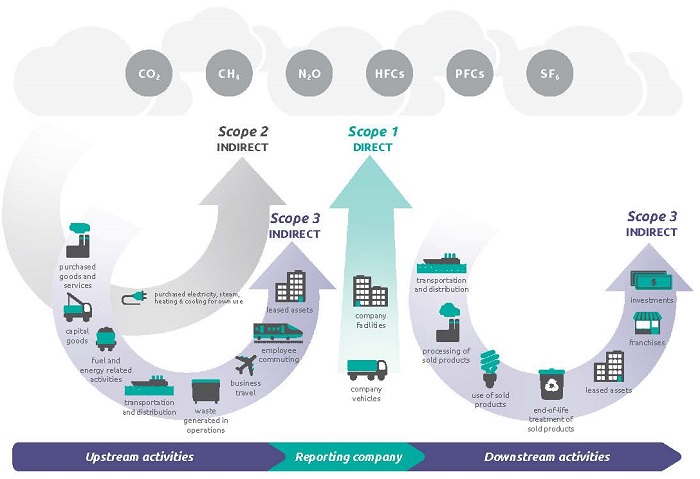
What are Scope 1, 2 and 3 emissions?
Scope 1: Direct emissions that result from activities within your organisation’s control. This might include onsite fuel combustion, manufacturing and process emissions, refrigerant losses or company vehicles.
Scope 2: Indirect emissions from electricity, heat or steam that you purchase and use. Although not directly in control of the emissions, by using the energy you are indirectly responsible for the release of CO2.
Scope 3: Any other indirect emissions from sources outside of your direct control. This category covers all the emissions associated, not with the company itself, but those for which the organisation is indirectly responsible up and down the value chain. This includes purchased goods and services, use of sold goods, business travel, commuting, waste disposal and water consumption.
The terms Scope 1, 2 and 3 emissions were created by the GHG Protocol in 2001, where their meaning is demonstrated in the following graphic:
Overview of GHG Protocol scopes and emissions across the value chain

Source: ghgprotocol.org
An environmental road map to transformation
Our environmental roadmap supports you at each stage of your transformation journey, whether you are starting from scratch or in the process of executing your strategy. This roadmap will help determine your scope 1, 2 and 3 emissions and what you need to report.
Benefits of a well-defined environmental strategy
- Reduces emissions and safeguards the business from rising carbon tax costs
- Reduces energy consumption and protects the business against energy price rises
- Supports alignment with regulations, compliance and aligns to international reporting standards (which includes disclosures around scope 1, 2 and 3 emissions)
- Reduces the negative impact of an organisation to the environment.
How we can help
We see the importance of being a sustainably profitable business where we can pay forward a valuable legacy to future generations. Sustainability lies at the heart of our business and we continually review the choices we make to ensure our firm is truly sustainable on many levels.
Subscribe for timely technical updates and keep on the pulse with industry developments




